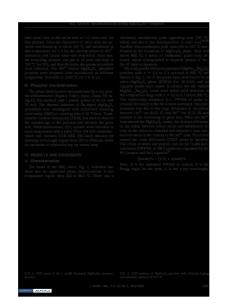Energy Focus: Improved light emission in Ce 3+ and Tb 3+ co-doped MgY 4 Si 3 O 13 phosphors
- PDF / 1,270,219 Bytes
- 2 Pages / 585 x 783 pts Page_size
- 83 Downloads / 444 Views
R
esearchers J. Xiao, J.P. Lemmon, and collaborators at Pacific Northwest National Laboratory picked up an old recipe and found out something new. The group synthesized nanocomposites of exfoliated MoS2 and polyethylene oxide (PEO) using an existing technique. This time, however, they electrochemically tested the composite as a negative electrode in Li-ion batteries. In the August 24th issue of Chemistry of Materials (DOI:10.1021/cm101254j; p. 4522), the researchers report that the nanocomposite with 5 wt% PEO revealed very high specific capacity (reaching 1131 mAh/g) and longer cycle life than MoS2 alone. Graphite, a conventional negative electrode battery material, has a theoretical capacity of 372 mAh/g. MoS2 is a promising alternative electrode material because it forms layers that are loosely coupled by weak van der Waals interactions, and the Li+ ions can diffuse in the layers without inducing large volume change. The researchers
Energy Focus Improved light emission in Ce3+ and Tb3+ co-doped MgY4Si3O13 phosphors
W
hite light-emitting diodes (LEDs) have recently been investigated to be employed in solid-state lighting device applications. A widely utilized approach to producing white LEDs is to combine blue LEDs with yellow-emitting phosphors (YAG: Ce3+). Consequently, these LEDs produce cool white emissions and a low color rendering index due to their weak emissions in the green and red spectral range. An alternate approach for white lighting applications uses tricolor (red, green, and blue)-emitting phosphors excited by ultraviolet (UV) LEDs. Conventional phosphors are not suitable for white light-emitting systems employing UV-LEDs due to their weak
found by scanning electron microscopy that exfoliated MoS2 with weight percents of 0, 5, and 15 PEO exhibits a layered morphology with the morExfoliated MoS w/o PEO phology becoming more distinct with increasing polymer addition. The x-ray diffraction data and high-resolution transmission electron microscopy (HRTEM) images of the 5 Comparison of cycling stability for unexfoliated MoS2 wt% PEO material showed and exfoliated MoS2 with different amounts of polyethylene that the polymer does not oxide (PEO). All cells were cycled between 0.01 V and 3.0 V at 50 mA/g. Solid symbols, Li insertion; open symbols, significantly affect the Li extraction. Reproduced with permission from Chem. d-spacing of exfoliated Mater. 22 (16) (2010) DOI:10.1021/cm101254j; p. 4522. © 2010 American Chemical Society. MoS2 in the composite, but a weak reflection in the enhance the ionic diffusion between elecx-ray diffraction data of trolyte and particles. the 15 wt% PEO material suggests that as The HRTEM micrographs showed more PEO is added, a more ordered comthat pristine, unexfoliated MoS2 existed posite phase begins to form. The researchers conclude that the very with the PEO/MoS2 nanocomposite in the high capacity and cycling stability of samples of prepared material. This finding 5 wt% PEO/MoS2 is due to PEO main“suggest[s] that it is possible to further improve the capac
Data Loading...










